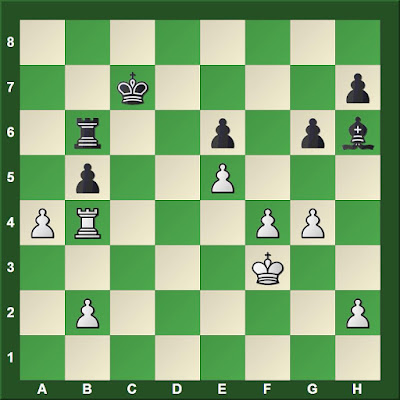This weekend is the 25th annual Dave Collyer Memorial chess tournament. It is Spokane's premier tournament--both largest and strongest. This year, four former winners--all masters--are competing. In the second round, I was paired against the fifth seed, the strongest non-master. He overlooked a nuance in a tactical sequence in the early middlegame that gave me a slight edge.
James Stripes (1845) -- Chris Kalina (2068) [D37]
25th Collyer Memorial Spokane Valley (2), 25.02.2017
White to move
 |
| After 21...Be4 |
23...Bxf1 24.Nxc8 It was the vulnerable bishop on e7 that my opponent overlooked when he forced the trade of queens 24...Bf8 25.Kxf1+-
24.Rxd3±
My chess engine insists this position is equal, but most human players would favor White.
24...Rd5 25.Rfd1 Rxd3 26.Bxd3 Nd5 27.Bg3 Bf6 28.e4 Ne7 29.e5
This move was a little hasty on my part.
29.Ba6 does more to improve my pieces relative to those of my opponent. I thought that I was trapping the bishop and moved instantly. Later, this bishop won the game in poetic recall of my round five game during the Spokane Chess Club's Winter Championship. A piece that seemed to be inactive became the star in the ending. See "Perseverance".
29...Bg5 30.f4 Bh6 31.Ba6 Rb8 32.Rd4 Nd5
White to move
We have reached the critical position where the middlegame must be played with clear understanding of what may go down in the endgame. Or perhaps, this is already the endgame because I determined that is was time to activate my king. Studying this position, I reasoned that my king was stronger than my opponent's king. My plan was to post my king on f3, protecting my f-pawn, so that my dark-squared bishop was free to harass Kalina's vulnerable b-pawns.
I failed to anticipate how Black could bring his king to the queenside the capture my light-squared bishop, and hence underestimated his next move.
33.Kf2?
33.Bc4 or another move of this bishop leaves me with an edge.
33...b5 34.Kf3 Kf8 35.Be1
35.Bf2 was hard to find, but protects the other bishop.
35...Ke8 36.Bxb4?
36.Bf2 maintains equality.
36...Rb6 37.Bc8 Nxb4
37...Bxf4 38.Ke4 Rb8 39.Ba6 Bxh2 is even better for Black.
38.Rxb4 Kd8 39.Bxe6 fxe6 40.a4 g6 41.g4 Kc7
I offered a draw a move or two before this point. Chris said, "maybe later", and played on.
White to move
42.Rxb5
I was too optimistic about being able to eliminate Black's e- and g-pawns.
42.axb5 leaves me with more options for counterplay.
42...Rxb5 43.axb5–+ Bf8 44.Ke4 Bc5 45.f5 Kd7?
My opponent pursues a plan that demonstrated his king to be stronger than mine, but this move could have squandered the win if I had calculated correctly later on.
45...Kb6–+
46.Kf4 Ke7
46...Be7–+
47.h4 Kf7 48.h5 Bb6
White to move
I spent a bit of time trying to find the draw. Of course, if I can leave my opponent with only the h-pawn, the draw is elementary. Understanding that, he labored to prevent it. That was the reasoning behind his move 45. In this position, I think I found the correct idea, but then three moves in, the lines crossed in my head and I fell short.
49.fxe6+ Kxe6 50.hxg6 hxg6 51.Kg5 Kf7
White to move
52.e6+??
52.Kh6 was necessary Be3+ 53.g5 Bd4 54.e6+ Kxe6 55.Kxg6=
52...Kg7–+ 53.Kf4 Kf6 54.e7 Kxe7 55.Kg5 Kf7 56.Kh6 Kf6 57.b3 g5 58.Kh5 Be3 59.b4 Ke5 60.b6 Kf4 61.b7 Ba7 62.b5 Bb8 63.b6 Bd6 0–1
It was hard for my unbeaten streak to come to an end. It was also hard to squander first an advantage, and then miss a draw. Even so, if I play today as well as I did in this game, I should at least finish the event with a far better performance than last year's Collyer (see "Bishop versus Knight").


















This is a tough one. I recently missed a clear pawns vs. bishop draw, too!
ReplyDeleteStill, good results for you lately. I guess the moral of this game was 1) missing the tactical idea of trapping your bishop slowly with ...b5 2) Lack of clear calculation at the end, or maybe fatigue. I suspect what you missed was 53.e7 Be3+ batting your king away and saving the g-pawn. Or perhaps you got carried away so close to making the draw and missed 52...Kg7 altogether.
I think that I saw a complex line that fails for Black if I played 52.Kh6. Something like 52...Bd8 53.e6+ Kf6 54.g5+ Kf5 55.b6 Bxg5 56.Kg7 and Black must give up the pawn, but I did not see this far clearly enough and went for the apparently simpler 52.e6. I had plaenty of time on my clock and could have taken a walk, eaten a cookie, drank some water, and then calculated correctly. But, I needed to understand that this was the critical move. I thought I had worked out the plan at move 49 and then moved quickly for the rest of the game.
Delete